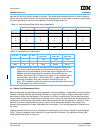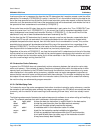
User’s Manual
PPC440x5 CPU Core Preliminary
Page 100 of 589
cache.fm.
September 12, 2002
Replacement Policy on page 96, the values of the fields are constrained to lie within the range specified by
the NFLOOR field of the corresponding victim limit register, and the last way of the cache (way 31 for the 8KB
cache size, way 63 for the 16KB or 32KB cache size). That is, when one of the normal victim index fields is
incremented past the last way of the cache, it wraps back to the value of the NFLOOR field of the associated
victim limit register.
Similarly, when a cache line fill occurs as the result of a transient memory access, the cache line to be
replaced is selected by the corresponding victim index field from one of the transient victim index registers
(ITV0–ITV3 for instruction cache lines, DTV0–DTV3 for data cache lines). As the processor increments any of
these transient victim index fields according to the round-robin replacement mechanism, the values of the
fields are constrained to lie within the range specified by the TFLOOR and the TCEILING fields of the corre-
sponding victim limit register. That is, when one of the transient victim index fields is incremented past the
TCEILING value of the associated victim limit register, it wraps back to the value of the TFLOOR field of that
victim limit register.
Given the operation of this mechanism, if both the NFLOOR and TFLOOR fields are set to 0, and the
TCEILING is set to the index of the last way of the cache, then all cache line fills—both normal and tran-
sient—are permitted to use the entire cache, and nothing is locked. Alternatively, if both the NFLOOR and
TFLOOR fields are set to values greater than 0, the lines in those ways of the cache whose indexes are
between 0 and the lower of the two floor values are effectively locked, as no cache line fills (neither normal
nor transient) will be allowed to replace the lines in those ways. Yet another example is when the TFLOOR is
lower than the NFLOOR, and the TCEILING is lower than the last way of the cache. In this scenario, the ways
between the TFLOOR and the NFLOOR contain only transient lines, while the ways between the NFLOOR
and the TCEILING may contain either normal or transient lines, and the ways from the TCEILING to the last
way of the cache contain only normal lines.
Programming Note: It is a programming error for software to program the TCEILING field to a
value lower than that of the TFLOOR field. Furthermore, software must
initialize each of the normal and transient victim index fields to values that
are between the ranges designated by the respective victim limit fields,
prior to performing any cacheable accesses intended to utilize these
ranges.
In order to setup a locked area within the data cache, software must perform the following steps (the proce-
dure for the instruction cache is similar, with icbt instructions substituting for dcbt instructions):
1. Execute msync and then isync to guarantee all previous cache operation have completed.
2. Mark all TLB entries associated with memory pages which are being used to perform the locking function
as caching-inhibited. Leave the TLB entries associated with the memory pages containing the data which
is to be locked into the data cache marked as cacheable, however.
3. Execute msync and then isync again, to cause the new TLB entry values to take effect.
4. Set both the NFLOOR and the TFLOOR values to the index of the first way which should be locked, and
set the TCEILING value to the last way of the cache.
5. Set each of the normal and transient victim index fields to the same value as the NFLOOR and TFLOOR.
6. Execute dcbt instructions to the cache lines within the cacheable memory pages which contain the data
which is to be locked in the data cache. The number of dcbt instructions executed to any given set should
not exceed the number of ways which will exist in the locked region (otherwise not all of the lines will be
able to be simultaneously locked in the data cache). Remember that when a series of dcbt instructions
are executed to sequentially increasing addresses (with the address increment being the size of a cache


















